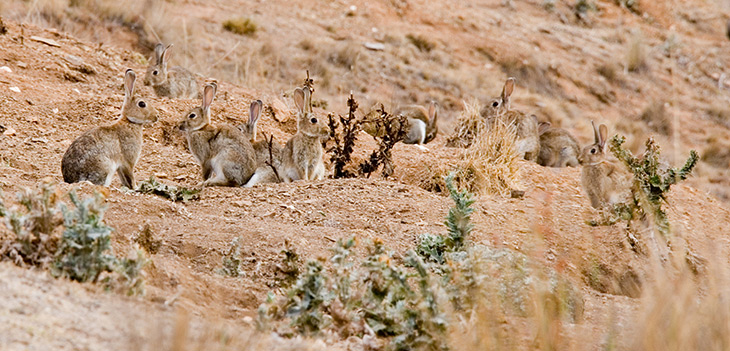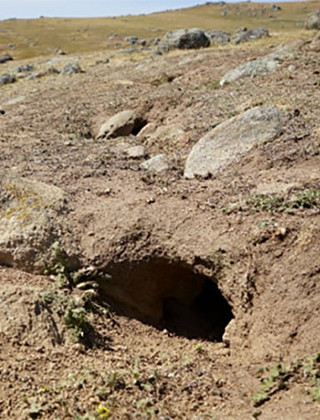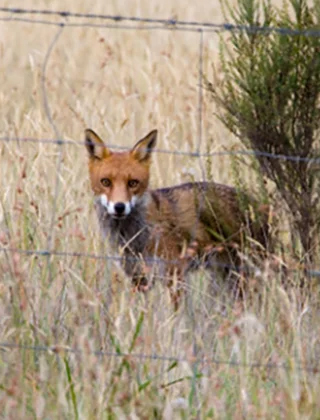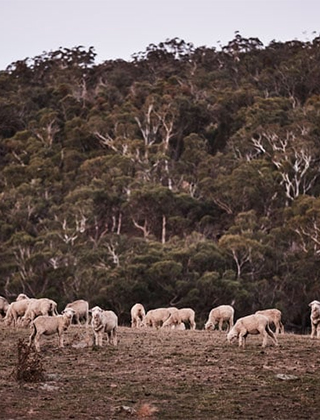RHDV2 Rabbit Calicivirus

The rabbit calicivirus RHDV2, which was discovered in the Australian landscape in 2015, is replacing RHDV1 biocontrol agents as the dominant RHDV field strain in Australian rabbit populations. Work is under way to determine whether RHDV2 would be a suitable registered biocontrol product, which would enable the strain to be used strategically by land managers as an additional biological control.
Wild rabbits are Australia’s most widespread and destructive agricultural and environmental vertebrate pest. PHOTO: John Schilling.
The rabbit calicivirus RHDV2, which was discovered in the Australian landscape in 2015, is replacing RHDV1 biocontrol agents as the dominant RHDV field strain in Australian rabbit populations. Work is under way to determine whether RHDV2 would be a suitable registered biocontrol product, which would enable the strain to be used strategically by land managers as an additional biological control.
Rabbits are an invasive pest that actively compete with Australian livestock and – particularly during drought – can strip pastures bare. Just two rabbits per hectare are enough to stop plant regeneration.
AWI is committed to maintaining downward pressure on rabbit populations to ensure ongoing environmental and production benefits. In general, rabbits are under reasonable control nationally. However, after the current drought there will again be strong upward pressure on rabbit populations.
For the past 60 years, rabbit biocontrol has had dramatic and widespread benefits to Australian agriculture and the environment, with benefits estimated at more than $70 billion. However, there is an ongoing need for new rabbit biocontrol agents to be released on a regular basis to counteract reduced effectiveness of existing agents (due to increasing immunity and genetic resistance).
In 2015, an exotic strain of rabbit haemorrhagic disease virus (RHDV), known as RHDV2, was discovered in the Australian landscape. Researchers from across Australia have been monitoring this virus intensively over the past few years and have found that it has suppressed rabbit abundances by an average of 60%, with impacts most pronounced in southern and western Australia.
This result was recently published in the Journal of Applied of Ecology, where the paper states that “serological analyses suggested that RHDV2 arrived in Australia during spring 2014 and spread rapidly through the Australian rabbit population within two years”.
IS RHDV2 BEING REGISTERED WITH THE APVMA AS A BIOCIDE?
We know that RHDV2 is effective at killing wild rabbits. The Centre for Invasive Species Solutions (CISS) is now working with researchers based at the CSIRO, NSW DPI, PIRSA and Vic DELWP to better understand its interactions with other strains of RHDV.
The ultimate goal is to determine whether RHDV2 could be registered as an additional biological control for strategic use for the landscape management of rabbits.
However, before RHDV2 can be registered through the Australian Pesticides and Veterinary Medicines Authority (APVMA), its efficacy needs to be demonstrated. Researchers are now carrying out efficacy testing of RHDV2 in adult and young rabbits, and also assessing the welfare impacts compared to that of other RHDV strains as well as other control options approved for rabbit management.
Work is also under way to better understand the extent to which RHDV2 can overcome acquired immunity to RHDV1, and vice versa, and researchers are aiming to understand how immunity passed on from mothers to their offspring influences the timing and outcome of an RHDV2 infection in very young rabbits.
AWI aims to invest $746,000 in the current three-year strategic period (2019/20 to 2021/22), on top of the $322,000 already invested in the previous two financial years, in these CISS rabbit biocontrol projects.
IS CISS STILL MONITORING DISEASE?
Absolutely, the national rabbit biocontrol monitoring program of CISS is still active, and the team will still provide free testing of rabbits that are found dead for all caliciviruses known to circulate in Australia.
Sampling kits include a sampling tube, detailed instructions how to collect a tissue sample and a return envelope, and can be requested via the RabbitScan website and results will be uploaded to the rabbit biocontrol tracker: www.feralscan.org.au/rabbitscan/map.aspx?mapMode=rhdv
The team is also investigating if flies can be used as an additional tool to monitor
continental scale activity of RHDV. Bushflies and blowflies are a known vector of RHDV, and fly sampling and analysis is carried out in regular intervals at selected sites across Australia to validate this method.
HOW WOULD RABBIT CONTROL BE IMPROVED IF RHDV2 WAS RELEASED STRATEGICALLY, RATHER THAN LETTING NATURE RUN ITS COURSE?
Natural outbreaks of RHDV (or RHDV2) occur when a sufficient number of susceptible animals has built up in the population (eg through breeding) that can carry an outbreak. Registered biocides and other controls can be applied to populations before this critical mass is reached, thereby preventing numbers from building up, resulting in less rabbit damage.
The monitoring of RHDV provides essential information regarding which virus is active when and where, and if/how this changes over time. This is important information that allows land managers to choose from the available biocontrols/biocides in a way that will maximise management outcomes.
A very important feature of RHDV is that it can fatally infect very young rabbits. In contrast, RHDV1 strains (such as K5) can infect young rabbits but does not kill them, and results in lifelong immunity in the surviving animals. This means that the application of K5 is not recommended during the breeding season as many young animals will survive and may become next year’s immune breeding population. If RHDV2 was available as a registered biocide, it could potentially be a more robust biocide that could be applied year-round, irrespective if rabbits are breeding or not.
RHDV is not a silver bullet. Rabbit biocontrol is beneficial when applied as part of an integrated and complementary pest management approach, including poison baiting, warren fumigation and ripping, and the removal of above ground harbour such as blackberry and lantana bushes.
MORE INFORMATION
www.wool.com/rabbits
www.pestsmart.org.au
This article appeared in the March 2020 edition of AWI’s Beyond the Bale magazine. Reproduction of the article is encouraged, however prior permission must be obtained from the Editor.















